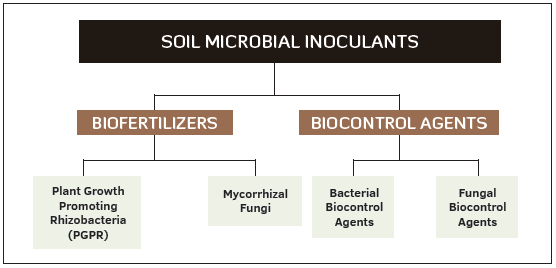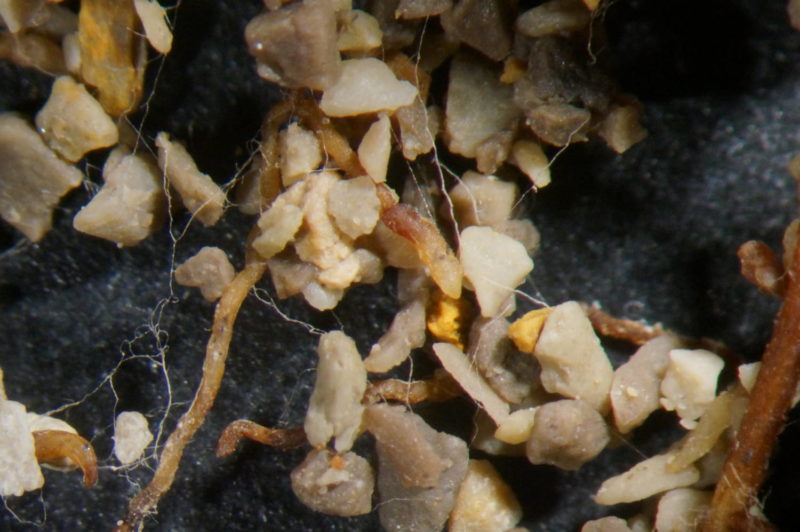Soil Microbial Inoculants: Biology and Commercial Use
Microbial inoculants are used for a variety of reasons; they can be applied to
promote plant health, improve vegetative growth, increase nutrient and water uptake, and elevate stress tolerance or treat specific diseases. With their use, growers are able to alter the microbial community in the soil for
these targeted uses. Soil microbial inoculants are widely accepted as potential alternatives or complements to chemical fertilizers and pesticides in agriculture and horticulture. Some of these products have been used commercially for decades, such as rhizobia, but the scientific community just recently started investigating their real modes of action.
THE RHIZOSPHERE
The soil is a remarkably complex and dynamic environment. Microorganisms are vital components of the soil. The soil layer impacted by the roots is called rhizosphere. This portion of the soil is heavily populated by microorganisms (e.g., bacteria and fungi). Each gram of soil in the rhizosphere can contain a billion bacteria or a million fungi. In this rhizosphere, plant roots interact extensively with soil microorganisms: a significant portion (5 to 21%) of the photosynthetic carbon is released, through exudation, in various forms into the soil by the roots. This is called the “rhizosphere effect.” Root exudates serve as a food source for rhizosphere microorganisms. These could be organic acids, amino acids, phenolics, plant growth regulators, vitamins, sugars and many other different chemicals.
Root exudates can modify the physical and chemical properties of the soil and thus regulate the structure of the soil microbial community in the immediate vicinity of the root surface. There are beneficial, neutral and harmful microorganisms and their balance determines plant health and its growth characteristics. In fact, plants have the ability to preferentially enrich distinct soil microbial communities through the production of root exudates.
TYPES OF SOIL MICROBIAL INOCULANTS
There are two main types of soil microbial inoculants (Figure 1) — biofertilizers and biocontrol agents. Biofertilizers are living microbes that enhance plant nutrition by either mobilizing or increasing nutrient availability in soils. Various microbial taxa including beneficial bacteria and fungi are currently used as biofertilizers, as they successfully colonize the rhizosphere, rhizoplane or root interior. Plant growth promoting rhizobacteria and mycorrhizal fungi are the most common biofertilizers in agriculture and horticulture.

The biocontrol agents protect plants from their natural enemies like parasites, from predation, etc. They help in controlling the infestation of plant pests such as weeds, nematodes, insects and mites. The biological control agents are specific to harmful organisms and do not kill beneficial organisms present in the soil. For commercial use, bacterial and fungal biocontrol agents are available for growers.
PLANT GROWTH PROMOTING RHIZOBACTERIA
The rhizosphere consists of bacteria named rhizobacteria, which either directly or indirectly exert positive effects on plants. Most of these soil bacteria colonize plant roots and benefit the plants by stimulating their growth and are therefore called plant growth promoting rhizobacteria (PGPR). They provide benefits to the plant via various mechanisms:
1. Nitrogen fixation: These bacteria convert atmospheric nitrogen into ammonia, which can be utilized by the plant as nitrogen source. The most common group of nitrogen fixing bacteria is called rhizobia, which forms a symbiosis with the host plant (e.g., Rhizobium, Mesorhizobium, Bradyrhizobium spp.). They live inside the plant and form nodules on the roots where the nitrogen fixation occurs. They are very common in agriculture in soybean production; in the horticulture industry, plants from the Fabaceae family (robinia, wisteria, baptisia, lupins) and dianthus can also benefit from inoculation with rhizobia. Besides rhizobia, there are free-living forms of nitrogen fixers (e.g., Azospirillum spp.) that live outside the roots.
2. Increasing the availability of nutrients in the rhizosphere: These are bacteria that provide benefits to the plant by converting non-soluble nutrients into bioavailable forms. For instance, the phosphorus solubilizers (e.g., Azotobacter, Bacillus, Pseudomonas spp.) increase the availability of bound-phosphorus in the soil by the production of phosphatase enzymes and organic acids. Siderophore producers are capable of producing chelators (siderophores) that help take up iron by plants (e.g., Rhizobium, Bradyrhizobium, Pseudomonas spp.).
3. Increasing root surface area or root architecture: Some bacteria, such as Pseudomonas fluorescens, produce auxins and other plant hormones as secondary metabolites that promote root growth. Some Bacillus species can also release volatile compounds to benefit the host plant.
4. Enhancing other beneficial symbioses: A group of PGPR helps the establishment and function of the mycorrhizal symbiosis with the plant. These bacteria are called mycorrhiza helper bacteria.
MYCORRHIZAL FUNGI
Several kinds of mycorrhizal fungi exist in nature. For horticultural use, arbuscular mycorrhizal fungi are the most common, which can provide benefits to most plant species including almost all major agricultural crops and herbaceous and shrub species in natural ecosystems.
The mycorrhizal fungi, after the biotrophic colonization of the root cortex, develop an external mycelium, which is a bridge connecting the root with the surrounding soil microhabitats. In the nearly ubiquitous symbiotic relationship between plant roots and mycorrhizal fungi, the latter have been shown to help plant acquire mineral nutrients from the soil, especially immobile elements such as phosphorus, zinc and copper, but also more mobile ions such as sulfur, calcium, potassium, iron, magnesium, manganese, chlorine, bromine and nitrogen. In soils, where such elements may be deficient or otherwise less available, mycorrhizal fungi increase efficiency of mineral uptake, resulting in, besides several other benefits, enhanced plant growth or increased yield.
The role mycorrhizal fungi play in plant nutrition and water acquisition is very important. Plants’ roots are limited to acquiring the nutrients and water from a finite volume of soil, directly contacting the plant’s root structures (“depletion zone”). Mycorrhizae grow out beyond this depletion zone and extract the nutrients and the water from a larger soil volume. They also produce enzymes that convert non-soluble nutrients into bio-available forms or soluble forms, and increase the production of solubilizing enzymes by the plants (they regulate molecular mechanisms in the plants to produce enzymes).

They also work together with other soil microorganisms, which help the fungus extract more nutrients from the soil. There are different mechanisms that these fungi employ, but overall, they provide a more efficient nutrient and water absorption to the plant which has many benefits to plant development.
BIOCONTROL AGENTS (BACTERIAL AND FUNGAL)
The biocontrol agents protect plants from their natural enemies. They help control, suppress or improve the natural tolerance of plants to pathogens and pests. The biological control agents are very specific to harmful organisms and do not kill useful organisms present in the soil. They employ various mechanisms to control pests and diseases:
1. Competitive exclusion: Some bacteria and fungi can prevent pathogens from becoming established by growing and covering a growth niche in the rhizosphere; this depletes crucial resources in that niche.
2. Antibiosis: A group of soil microorganisms produces chemical metabolites that inhibit the pest pathogen. For instance, these metabolites can be natural antibiotics that prevent microbial growth or can be degrading enzymes (chitinases, glucanases, peroxidases).
3. Predation or parasitism: Bacteria, such as Streptomyces spp., can directly parasitize pathogens and kill them. They inhibit spore germination and prevent hyphal growth of the pathogenic fungi.
4. Induction of host plant resistance: Some bacterial and fungal biocontrol agents can prime the plant’s immune system with their presence. They reduce the effects of pathogens and thus the plant is less vulnerable to future pathogen attacks.
For best efficacy, biocontrol agents must be applied preventatively (e.g., Streptomyces lydicus, Trichoderma spp.) It takes some time to develop a critical mass population for disease control. Typically, multiple applications are required and multiple applications at lower rates are often more effective than few applications at higher rates.
SOME PRACTICAL CONSIDERATIONS
Soil microbial inoculants come in various formulations from dry powders to granules and liquids. Inert materials (e.g., peat moss, vegetable oil) are often used as carriers to keep the microorganisms alive and aid in application.
There are several methods of applying soil inoculants from coating of the seeds or seedling, soil drench, incorporation into growing media. Microbial soil inoculants need to be applied in the root zone. Direct soil applications are usually made at the base of the plant near plant roots. Once mixed up, it is best to use it as quickly as possible.
Shelf-life can be limiting (these inoculants contain living organisms). Several PGPR products require to be kept refrigerated until use. Shelf-life ranges from six months to two or more years. It is important to avoid exposure to extreme temperatures.
Often specific microbial species/strains are required for best efficacy (e.g., Rhizobia, Trichoderma spp.).
Microbial soil inoculants have to colonize the rhizosphere for sufficient efficacy. The success of the inoculant is more linked to the ability of the microorganism to reproduce and establish effective populations in the rhizosphere than the concentration of the applied inoculum (less “rate-response” than in traditional pesticides). Introduced microorganisms compete with those already in the soil and survive predation from native organisms (e.g., protozoa, nematodes).
• Introduced microorganisms can be impacted by pesticides, fertilizers, agricultural management practices (Critical stage is after inoculation):
• They may not persist for a long time, re-application needed (PGPR)
• Population increases over time
(Mycorrhizal fungi)
• Biofertilizers are often most effective under poor soil conditions.


 Video Library
Video Library 




















